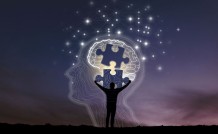Online Class: Child Psychology 101

no certificate
with CEU Certificate*
-
11Lessons
-
14Exams &
Assignments -
4,403Students
have taken this course -
7Hours
average time -
0.7CEUs
Course Description
This course introduces the methods, theories and main concepts used by psychologists to develop a real insight into the world of children.
Child psychology is extremely important for a number of reasons, not the least of which is being able to understand and accurately predict a reasonable norm for child development. Proper discipline, teaching styles and communication styles are all based on understanding the psychology of childhood, which changes and develops over time. Intervention on behalf of children who have been raised in difficult circumstances or faced traumatic events also hinges on understanding child psychology -- children don't cope with situations in the same way adults do because they do not process information the same way and do not have the same emotional or reasoning skills.
By studying child psychology, we can better understand children and equip them to become well-adjusted, more adaptable adults who are capable of living rich and varied lives. We can help our children through crises and enrich their daily lives by interacting with them in ways that are appropriate to their developmental levels. Is it any wonder that so many people choose to study child developmental psychology every year?
This course is for all those who want to find out what psychology can tell us about the nature and development of children. This study is intended for students of psychology , those training to work with children in a variety of professional roles, or anyone just interested in understanding how children develop.
Course Motivation
Most people think of childhood as that youthful time of innocence when there is little or no responsibility and parents take care of all the needs and wants of their offspring. In fact, the idea of childhood as most people think of it today is a relatively recent concept.
The bond between children and parents was certainly there, but probably was not as exclusive or as intense as it is today for a number of reasons. Most households had numerous children, so there was less focus on the individual child, and older children tended to contribute a great deal toward child-rearing duties. Parents worked from sunrise to sunset in most homes and there was little time left over for play. The phrase, "It takes a village to raise a child," is apt, as children were often left to their own devices by necessity.
Once the age of "extended infancy" (lasting as long as six years) was over, children were viewed as young adults and the demands to act as such were truly in place. The expectations depended upon whether they were the children of merchants, farmers, or the nobility, but the essential fact was the same, children were expected to grow up quickly.
Class Differences in the Perception of Childhood
Children were dressed as replicas of their adult counterparts and expected to be able to perform adult tasks from the Middle Ages through the seventeenth century. The adult clothing reflected the perception that children over the age of seven or eight were smaller versions of their adult counterparts. The lives children led reflected this as well, although class differences were profound.
In medieval times in the upper classes, it was considered acceptable to pledge children to arranged marriages when they were seven years of age or older. Although the marriages were not consummated until later, the young brides would sometimes go to live with the groom's family until the actual wedding took place years later. During this period, they would learn how to be the lady of the manor. Young males from prominent homes were frequently assigned to knights as squires when they were about eight years old to begin learning the rules of knighthood and to serve as pages. In fact, as squires these children might accompany their knight to the battlefield even at these young ages.
The children of farmers and serfs were put to work in the fields as soon as they were able to do physical labor. This was not because the parents did not care for their children, but it was simply a matter of survival. The idea that at this age children were not emotionally ready to set aside imaginary play for the responsibilities of adulthood was foreign to parents, everyone had to do their fair share to get by.
The merchant class allowed their children the longest length of what could be considered a true childhood. This was primarily because the children were neither important enough to be considered bargaining chips in arranged marriages or trained for knighthood, nor were they necessary for physical labor at such a young age. In fact, schooling was given to many merchant children for a longer length of time so that they could then take over the family business as adults. The opportunity for schooling rather than going directly into the work force allowed for more social interaction with other children, opportunities for play, and a few crucial years to mature with their peers.
The Industrial Revolution and Childhood
The rise of industrialization and increased urbanization in the nineteenth century caused another profound shift in what defined childhood. In the early years of the Industrial Revolution, there was a significant need for labor, which was filled by children in sweatshops, factories, and even mines. Rather than working for and with their own families, these children began working for strangers to earn wages that would help their families survive.
As technology advanced, however, production efficiency in factories and mines increased and the labor requirements decreased. By the late 1800s, fewer and fewer children were needed in the work force, creating a growing problem with children who were at loose ends in rural areas. Public schools were established not only to educate children but also to control them and keep them off the streets.
At the same time that public schools became more common, labor reform and child welfare reform swept across both Europe and the United States. The minimum working age for children was raised, and the maximum hours they were allowed to work were reduced. Parents, however, often opposed this extension of childhood because they preferred the wages that their children would have earned to the educational opportunities offered during the first few generations of the Industrial Revolution.
This opposition to lengthening childhood was more stubborn in the lower classes, where life was harsher and there was less time available for parents to devote to their children. In the higher classes, parents naturally had more time available for nurturing and establishing ties with their children as education at home and interaction with them became more common. It is obvious that the differences were not because the parents in the lower classes cared less about their children, but because often their dire economic situation simply left them with little time or energy to provide a childhood for their children.
The Rise and Fall of the Nuclear Family
The concept and structure of the family is very different depending upon cultural and societal settings; these in turn have an impact on how child psychology is understood to some extent. While many aspects such as intellectual developmental milestones are relatively universal, others such as the impact of the mother-child relationship are affected by the norms of the culture.
In most Western cultures, the nuclear family began a steady rise after the turn of the century. As families became smaller and there was no longer a need for children to contribute economically at a young age, families became better able to establish independent households rather than having multiple generations living together.
After World Wars I and II, the increasing diversity of job opportunities and shifting of populations made the nuclear family of father, mother, and children even more prevalent. By the 1950s, the nuclear family was both the norm and the ideal, particularly in the United States. Childhood became a world within itself of safety and security. More than any other time in history, women focused primarily on childrearing and care of the home. This trend continued well into the mid-twentieth century, creating an environment that focused on childhood as never before.
In the late twentieth century, the economy and women's dissatisfaction with remaining at home (where modern conveniences meant chores were quickly completed) again sent them into the workforce in increasing numbers. As more women returned to work, men became more involved in child rearing and nurturing activities. The increasing acceptance of divorce and unusual family structures also contributed to the decline of the nuclear family.
Today there is an endless mix of family structures beyond the nuclear family, including step-families, single parent, and same sex parent families. In fact, in the U.S. there is presently no one type of household make-up that is prevalent enough to be considered "average." All of these diverse households create unique bonds and tensions that affect the childhood experiences of children and need to be taken into consideration by those studying child psychology.
- Completely Online
- Self-Paced
- Printable Lessons
- Full HD Video

- 6 Months to Complete
- 24/7 Availability
- Start Anytime
- PC & Mac Compatible
- Android & iOS Friendly
- Accredited CEUs

Course Lessons
Lesson 1. The Concept of Childhood
 Lesson 1 Video
Lesson 1 Video Lesson discussions: Reasons for Taking this Course
Lesson discussions: Reasons for Taking this Course Complete: Lesson 1 Assignment
Complete: Lesson 1 Assignment Assessment: Lesson 1 Exam
Assessment: Lesson 1 Exam
Lesson 2. Early Biological Factors in Child Psychology
 Lesson 2 Video
Lesson 2 Video Assessment: Lesson 2 Exam
Assessment: Lesson 2 Exam
Lesson 3. Major Schools of Child Psychology
 Lesson 3 Video
Lesson 3 Video Assessment: Lesson 3 Exam
Assessment: Lesson 3 Exam
Lesson 4. Piaget's Theory of Cognitive Development
 Lesson 4 Video
Lesson 4 Video Assessment: Lesson 4 Exam
Assessment: Lesson 4 Exam
Lesson 5. Vygotsky's Theory of Social Cognitive Development
 Lesson 5 Video
Lesson 5 Video Complete: Lesson 5 Assignment
Complete: Lesson 5 Assignment Assessment: Lesson 5 Exam
Assessment: Lesson 5 Exam
Lesson 6. Erikson's Eight Stages of Development
 Lesson 6 Video
Lesson 6 Video Lesson discussions: Child Development Theories
Lesson discussions: Child Development Theories Assessment: Lesson 6 Exam
Assessment: Lesson 6 Exam
Lesson 7. Development of Language
 Lesson 7 Video
Lesson 7 Video Lesson discussions: First Words
Lesson discussions: First Words Assessment: Lesson 7 Exam
Assessment: Lesson 7 Exam
Lesson 8. Nature versus Nurture
 Lesson 8 Video
Lesson 8 Video Lesson discussions: Nature or Nurture
Lesson discussions: Nature or Nurture Complete: Lesson 8 Assignment
Complete: Lesson 8 Assignment Assessment: Lesson 8 Exam
Assessment: Lesson 8 Exam
Lesson 9. Family Dynamics and Child Psychology
 Lesson 9 Video
Lesson 9 Video Assessment: Lesson 9 Exam
Assessment: Lesson 9 Exam
Lesson 10. Applied Child Psychology
 Lesson 10 Video
Lesson 10 Video Assessment: Lesson 10 Exam
Assessment: Lesson 10 Exam
Lesson 11. Psychological Testing and Children
 Lesson 11 Video
Lesson 11 Video Lesson discussions: How would you rate this course?; Program Evaluation Follow-up Survey (End of Course); Course Comments
Lesson discussions: How would you rate this course?; Program Evaluation Follow-up Survey (End of Course); Course Comments Assessment: Lesson 11 Exam
Assessment: Lesson 11 Exam
Learning Outcomes
- Define what child psychology is.
- Recognize early biological factors in child psychology.
- Describe the major schools of child psychology.
- Summarize Piaget's Theory of Cognitive Development.
- Summarize Vygotsky's Theory of Sociocognitive Development.
- Define Erikson's Eight Stages of Development.
- Describe the processes of the development of language.
- Define nurture.
- Summarize the affect of family dynamics on child psychology.
- Demonstrate mastery of lesson content at levels of 70% or higher.
Additional Course Information

- Document Your Lifelong Learning Achievements
- Earn an Official Certificate Documenting Course Hours and CEUs
- Verify Your Certificate with a Unique Serial Number Online
- View and Share Your Certificate Online or Download/Print as PDF
- Display Your Certificate on Your Resume and Promote Your Achievements Using Social Media

Choose Your Subscription Plan
No Certificate / No CEUs
This course only
| Includes certificate | X |
| Includes CEUs | X |
| Self-paced |

|
| Instructor support |

|
| Time to complete | 6 months |
| No. of courses | 1 course |
Certificate & CEUs
This course only
| Includes certificate |

|
| Includes CEUs |

|
| Self-paced |

|
| Instructor support |

|
| Time to complete | 6 months |
| No. of courses | 1 course |
Certificates & CEUs
Includes all 600+ courses
| Includes certificate |

|
| Includes CEUs |

|
| Self-paced |

|
| Instructor support |

|
| Time to complete | 12 Months |
| No. of courses | 600+ |
Certificates & CEUs
Includes all 600+ courses
| Includes certificate |

|
| Includes CEUs |

|
| Self-paced |

|
| Instructor support |

|
| Time to complete | 24 Months |
| No. of courses | 600+ |
Student Testimonials
- "He was very informative, full of good advice." -- Joyce S.
- "I loved the course, and instructor is well organized, expert, and helpful. Thank you" -- Golam G.
- "I believe that each chapter offered a great deal of information, and excellent links to get more material on the that chapter." -- Golam G.
Related Courses
-
 29 hours
2.9 CEUs
Human Resources Productivity Course Bundle
$120.00
29 hours
2.9 CEUs
Human Resources Productivity Course Bundle
$120.00
-
 21 hours
2.1 CEUs
Ultimate Parenting Course Bundle
$135.00
21 hours
2.1 CEUs
Ultimate Parenting Course Bundle
$135.00
-
 7 hours
0.7 CEUs
Interpersonal Communication
$95.00
7 hours
0.7 CEUs
Interpersonal Communication
$95.00
-
 7 hours
0.7 CEUs
Solving Classroom Discipline Problems
$95.00
7 hours
0.7 CEUs
Solving Classroom Discipline Problems
$95.00
-
 9 hours
0.9 CEUs
Business Management
$110.00
9 hours
0.9 CEUs
Business Management
$110.00
-
 5 hours
0.5 CEUs
Team Building 101
$95.00
5 hours
0.5 CEUs
Team Building 101
$95.00
-
 7 hours
0.7 CEUs
Personality Development
$95.00
7 hours
0.7 CEUs
Personality Development
$95.00
-
 5 hours
0.5 CEUs
Lawful Employee Termination
$95.00
5 hours
0.5 CEUs
Lawful Employee Termination
$95.00
-
 7 hours
0.7 CEUs
Sensitivity Training for the Workplace
$95.00
7 hours
0.7 CEUs
Sensitivity Training for the Workplace
$95.00
-
 7 hours
0.7 CEUs
Leadership Skills for Managers
$95.00
7 hours
0.7 CEUs
Leadership Skills for Managers
$95.00
-
 6 hours
0.6 CEUs
Delegation Skills
$95.00
6 hours
0.6 CEUs
Delegation Skills
$95.00
-
 5 hours
0.5 CEUs
Child Safety for Parents
$95.00
5 hours
0.5 CEUs
Child Safety for Parents
$95.00
-
 7 hours
0.7 CEUs
Innovative Thinking
$95.00
7 hours
0.7 CEUs
Innovative Thinking
$95.00
-
 8 hours
0.8 CEUs
Meditation 101: Learn How to Meditate
$95.00
8 hours
0.8 CEUs
Meditation 101: Learn How to Meditate
$95.00
-
 5 hours
0.5 CEUs
Creative Thinking
$95.00
5 hours
0.5 CEUs
Creative Thinking
$95.00
-
 6 hours
0.6 CEUs
Management Essentials
$95.00
6 hours
0.6 CEUs
Management Essentials
$95.00
-
 7 hours
0.7 CEUs
Understanding Learning Styles
$95.00
7 hours
0.7 CEUs
Understanding Learning Styles
$95.00
-
 6 hours
0.6 CEUs
Gender Sensitivity Training
$95.00
6 hours
0.6 CEUs
Gender Sensitivity Training
$95.00
-
 8 hours
0.8 CEUs
Decision Making Skills
$95.00
8 hours
0.8 CEUs
Decision Making Skills
$95.00
-
 6 hours
0.6 CEUs
Organizational Psychology 101
$110.00
6 hours
0.6 CEUs
Organizational Psychology 101
$110.00
-
 16 hours
1.6 CEUs
Psychology 101
$95.00
16 hours
1.6 CEUs
Psychology 101
$95.00
-
 3 hours
0.3 CEUs
Building Self Esteem
$95.00
3 hours
0.3 CEUs
Building Self Esteem
$95.00
-
 9 hours
0.9 CEUs
Counseling Psychology 101
$95.00
9 hours
0.9 CEUs
Counseling Psychology 101
$95.00
-
 11 hours
1.1 CEUs
Mediation 101
$95.00
11 hours
1.1 CEUs
Mediation 101
$95.00
-
 7 hours
0.7 CEUs
Healthy Relationships
$95.00
7 hours
0.7 CEUs
Healthy Relationships
$95.00
-
 8 hours
0.8 CEUs
Crisis Management 101
$95.00
8 hours
0.8 CEUs
Crisis Management 101
$95.00
-
 11 hours
1.1 CEUs
Special Education 101
$95.00
11 hours
1.1 CEUs
Special Education 101
$95.00
-
 4 hours
0.4 CEUs
How To Be a Substitute Teacher
$95.00
4 hours
0.4 CEUs
How To Be a Substitute Teacher
$95.00
-
 5 hours
0.5 CEUs
Kaizen 101 - An Introduction
$95.00
5 hours
0.5 CEUs
Kaizen 101 - An Introduction
$95.00
-
 17 hours
1.7 CEUs
Mixed Media Art
$95.00
17 hours
1.7 CEUs
Mixed Media Art
$95.00
-
 4 hours
0.4 CEUs
Second Grade Curriculum
$95.00
4 hours
0.4 CEUs
Second Grade Curriculum
$95.00
-
 9 hours
0.9 CEUs
Product Management 101
$95.00
9 hours
0.9 CEUs
Product Management 101
$95.00
-
 9 hours
0.9 CEUs
Introduction to Six Sigma
$95.00
9 hours
0.9 CEUs
Introduction to Six Sigma
$95.00
-
 10 hours
1.0 CEUs
Learning Disabilities: What You Need to Know
$95.00
10 hours
1.0 CEUs
Learning Disabilities: What You Need to Know
$95.00
-
 3 hours
0.3 CEUs
Problem Solving Strategies
$95.00
3 hours
0.3 CEUs
Problem Solving Strategies
$95.00
-
 9 hours
0.9 CEUs
Watercolor Painting 101
$95.00
9 hours
0.9 CEUs
Watercolor Painting 101
$95.00
-
 7 hours
0.7 CEUs
Kinesics 101 - Learn to Read Body Language
$95.00
7 hours
0.7 CEUs
Kinesics 101 - Learn to Read Body Language
$95.00
-
 8 hours
0.8 CEUs
Early Childhood Development 101
$95.00
8 hours
0.8 CEUs
Early Childhood Development 101
$95.00









